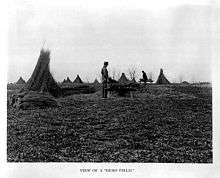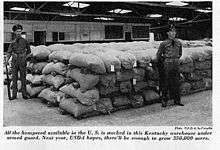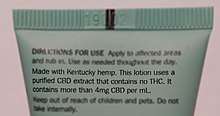Hemp in Kentucky
Kentucky was the greatest producer of hemp in the United States during the 19th and 20th centuries, when it was the source of three fourths of U.S. hemp fiber. Production started to decline after World War I due to the rise of tobacco as the cash crop in Kentucky and the foreign competition of hemp fibers and finished products. In 1970, federal policies virtually banned the production of industrial hemp during the War on Drugs saying all Cannabis sativa is a Schedule I controlled substance. Federal law under the Agricultural Act of 2014 allowed research back into hemp. Kentucky began production again with 33 acres in 2014. As of 2016 harvest season, only two U.S. states other than Kentucky had over 100 acres (40 ha) in hemp production: Colorado and Tennessee. The first 500-acre commercial crop was planted in Harrison County in 2017, and research permits were issued for over 12,000 acres (4,900 ha) that year. The 2016 documentary Harvesting Liberty concerns the 21st century Kentucky hemp industry.

History
Early cultivation


In the 18th century, John Filson wrote in Kentucke and the Adventures of Col. Daniel Boone (an appendix of his 1784 work The Discovery, Settlement and Present State of Kentucke) of the quality of Kentucky's land and climate for hemp production.[1] The first hemp crop in Kentucky was raised near Danville in 1775.[2][3][4]
Kentucky was the greatest producer of U.S. hemp in the 19th and 20th centuries, with thousands of acres of hemp in production.[5][lower-alpha 1] Senator Henry Clay was a "hemp pioneer" and the "strongest advocate" of Kentucky hemp. He grew it on his Kentucky estate Ashland and brought new seeds to the state from Asia.[7][8][9][10] Clay's oratory on the Senate floor in 1810 in favor of requiring the Navy to use domestic hemp exclusively for ship's rigging was widely reprinted in newspapers and is credited for beginning the elaboration of the American System.[11] According to a 1902 periodical, Kentucky was responsible for three quarters of U.S. hemp fiber production.[12] Production reached a peak in 1917 at 18,000 acres, mostly grown in the Bluegrass region, then waned due to market forces after World War I as other sources of fiber were introduced.[13][14] A Federal program to reintroduce hemp for wartime needs in Kentucky and other states during World War II reached 52,000 acres in Kentucky in 1943.[15]:1 The WWII effort is documented in the U.S Department of Agriculture film Hemp for Victory .[16]
Decline and criminalization
Production of hemp had seen a decline after World War I due to market forces including the rise of tobacco as the cash crop of choice in Kentucky and foreign sources of hemp fiber and finished products.[17] The availability of cheap synthetic fiber after World War II even further discouraged farmers from growing it.[18]
Federal policies, tightened by the Controlled Substances Act of 1970, virtually banned the production of industrial hemp during the War on Drugs. According to an industry group, "the 1970 Act abolished the taxation approach [of the 1937 Marijuana Tax Act] and effectively made all cannabis cultivation illegal".[19] The Drug Enforcement Administration (DEA) refused to issue permits for legal hemp cultivation[lower-alpha 2] and held that, since industrial hemp is from the same species plant as prohibited cannabis (despite its being of lower THC yield), both were prohibited under the Controlled Substances Act.[18][21] In the words of a 2015 PBS NewsHour segment on hemp, "[t]o the federal government, hemp is just as illegal as marijuana",[22] and according to Newsweek, "all cannabis sativa—whether grown to ease chronic pain, get stoned or make rope—is a schedule I controlled substance".[8]
During this criminalized period, the Cornbread Mafia began its illegal cultivation of marijuana by cross-breeding imported cannabis seeds with native hemp plants left behind after the "Hemp For Victory" period in World War II.[23]
Partial re-legalization
By the late 20th century, consumer demand for hemp products was resurgent but American farmers were left as bystanders. Imported agricultural products were allowed from other countries, including Canada, but growing hemp legally was not possible in the United States.[24][lower-alpha 3] In 1994, Kentucky was one of the first states to consider reintroducing hemp cultivation, with a commission convened by governor Brereton Jones to investigate legal pathways to do so.[25] In 2013, Kentucky passed a state law, Senate Bill 50, allowing production for agricultural research purposes. Although the Industrial Hemp Farming Act of 2013, which would have allowed hemp production, failed,[15]:2 agricultural hemp was allowed by federal law under the Agricultural Act of 2014 (farm bill).[8][26] 33 acres in 2014,[27] 922 acres in 2015,[27] 2,350 in 2016,[27] 12,800 acres in 2017,[28] and 6,700 acres in 2018.[29] As of 2016 harvest season, only two U.S. states other than Kentucky had over 100 acres (40 ha) in hemp production: Colorado and Tennessee.[30]
The Industrial Hemp Research Program was conducted under the auspices of the Kentucky Department of Agriculture. Research at the University of Kentucky's Spindletop Research Farm sought to improved agronomy and includes research on optimizing cannabinoid yield.[31][32] The first research crops at Spindletop and Murray State University were planted in May 2014, with seed obtained from California and, after a legal battle with the DEA, imported from Italy.[33][34] The researchers are also engineering new mechanical harvesters that can reach the 10–12-foot (3.0–3.7 m) high flowers of tall-growing hemp.[35] The first 500-acre commercial crop was planted in Harrison County in 2017,[36] and research permits were issued for over 12,000 acres (4,900 ha) that year.[37]
Legal status
Under federal law, the THC present in both cannabis and hemp remains a Schedule I controlled substance.[20] Under state law, all hemp grown in compliance with the 2014 farm bill must have a delta-9 THC content not more than 0.3%.[38] Farmers participating in the program must use seeds provided by an educational institution with a DEA license and use varieties expected to be low in THC. A sample of each farmer's hemp crop is tested by the state.[27][39]
Under the 2018 United States farm bill, commodity hemp production was federally legalized.[40]
Production

Businesses exist in Kentucky which provide agricultural products based on hemp or supporting hemp production. Cynthiana-based Ananda Hemp has been operating in the Commonwealth since 2014.[41]
Oil extraction
Testing of a $400,000 oil extraction facility in Winchester began in March 2016, with full production capacity of 20,000 lb (9,100 kg) per hour expected by the end of the year.[42] GenCanna and Atalo Holdings are hopeful of turning their property at Winchester into a "Hemp Research Campus".[8]
Seed production
Three varieties of hemp seed from Lexington seed company Schiavi Seeds were the first to be certified by Colorado Department of Agriculture.[43] Certified in late 2016 for the 2017 Colorado crop, the varieties were originally from Italy and Serbia.[44][45]
Documentaries and Books
Documentary films concerning Kentucky hemp have included Hemp for Victory (U.S. Department of Agriculture, 1942) and Harvesting Liberty (Mike Lewis, 2016), which shows farmers in rural Kentucky considering hemp farming for food, fuel and fiber.[46]
The nonfiction book, The Cornbread Mafia by James Higdon has 14 references to Kentucky hemp.[47]
Footnotes
- "From the end of the Civil War until 1912, virtually all hemp in the US was produced in Kentucky."[6]
- A legal scholar wrote in 1999, "By law, industrial hemp is classified as a Schedule I controlled substance because of its distant relationship to the much higher tetrahydrocannabinol (THC)-containing plant, marijuana. Anyone wishing to grow, cultivate, or manufacture a Schedule I controlled substance must obtain licensing permission from the D.E.A. ... [I]ndustrial hemp cannot be legally grown in the United States because the D.E.A. refuses to grant farmers and entrepreneurs the required permit, Number 225, which would allow the licensee to "manufacture" a "controlled substance." The D.E.A. has never granted these permits."[20]
- According to Purdue researchers in 2002, "In the US, a substantial trade in hemp products has developed, based on imports of hemp fiber, grain, and oil. The American agricultural community has observed this, and has had success at the state level in persuading legislators of the advisability of experimental hemp cultivation as a means of evaluating the wisdom of re-establishing American hemp production."[6]
References
Citations
- Hopkins 2015, p. 13.
- "History of hemp in Kentucky". Kentucky Department of Agriculture. 2016. Archived from the original on October 15, 2017.
- "Courthouse lawn, US 127, Danville". Kentucky Historical Marker Database. Kentucky Historical Society. Marker 1279. Retrieved February 24, 2019.
Kentucky's first recorded hemp crop, 1775, was on Clark's Run Creek, near Danville. Grown by Archibald McNeill, who brought the first seed with him when he located here.
(search marker 1279 to locate record) - "Kentucky's history of hemp growing". AppalachiCanna. Retrieved May 28, 2020.
- Hopkins 2015, p. 215 "For well over a century, the state was the heart and center of the American hemp industry. Most of the fiber produced in this country grew in Kentucky, and most of the manufactories of domestic hemp were concentrated there."
- Small & Marcus 2002.
- "History-making hemp harvest at Henry Clay Estate". Lexington, Kentucky: WKYT-TV. August 30, 2016. Retrieved February 24, 2019.
- Firger, Jessica (October 23, 2015). "The Great Kentucky Hemp Experiment". Newsweek. Retrieved February 23, 2019.
- "April 8th, 1837: Henry Clay Experiments With New Type of Hemp Seed, Hoping to Introduce it in America". The Raab Collection. Archived from the original on November 22, 2016.
- Danish, Paul (April 5, 2018), "The gentlemen from Kentucky rise to speak for hemp", Boulder Weekly, retrieved February 23, 2019
- Heidler & Heidler 2010.
- Pattengill, H.R. (December 19, 1902), "The American hemp industry", Timely Topics, Lansing, Michigan, 7 (16), p. 267
- Hopkins 2015, p. 208.
- Dewey, Lyster H.; Merrill, Jason L. (October 14, 1916). "Hemp hurds as paper-making material". U.S. Department of Agriculture. p. 5. USDA Bulletin 404 – via Internet Archive.
- "Economic Considerations for Growing Industrial Hemp: Implications for Kentucky's Farmers and Agricultural Economy" (PDF). Department of Agricultural Economics, University of Kentucky. July 2013. Retrieved February 24, 2019.
- Hemp for Victory transcript via Schaffer Library of Drug Policy: "This film is designed to tell farmers how to handle this ancient crop now little known outside Kentucky and Wisconsin." Accessed February 24, 2019.
- Hopkins 2015, pp. 193–208.
- "Farmers sue DEA for right to grow industrial hemp". CNN. October 18, 2007. Retrieved February 24, 2019.
- West, David P. Ph.D. (February 27, 1998). "Hemp and Marijuana: Myths & Realities". North American Industrial Hemp Council. Archived from the original on November 20, 2016.
- Shepherd 1999.
-
Moore, Catherine V. (July 20, 2016), "Can Industrial Hemp Save Kentucky's Small Farms?", Yes!, retrieved February 23, 2019,
When you ask Kentuckians what they need to make hemp a success, their first answer is always to take the plant off the federal list of controlled substances.
- "Kentucky farmers quitting tobacco, turning to unlikely new crop". PBS Newshour. October 17, 2015. Retrieved February 24, 2019.
- James Higdon The Cornbread Mafia, Lyons Press, 2012, p. xviii
- Clarke & Merlin 2013, p. 239.
- Ballanco 1995.
- Roenker, Robin (January 2016). "Industrial hemp returns to Kentucky". Kentucky Living. Archived from the original on February 7, 2016.
- Mason, Charles (October 14, 2016). "State expects hemp program to grow". Bowling Green Daily News. Retrieved February 24, 2019.
- Matt Combs (November 27, 2017), "Year closes on first public industrial hemp grown in decades", The Register-Herald, Raleigh County, West Virginia, retrieved February 24, 2019
- Schreiner, Bruce (November 28, 2018). "McConnell's year-end wish: Getting Congress to legalize hemp". Associated Press. Retrieved February 24, 2019.
- "Hemp's future hazy as U.S. crop". Associated Press. August 23, 2016. Retrieved February 23, 2019 – via Toledo Blade.
[O]nly three states currently have more than 100 acres in [hemp] — Colorado, Kentucky, and Tennessee.
- Pratt, Katie (May 13, 2015). "UK plants hemp research plots". UK AgNews. University of Kentucky College of Agriculture, Food, and Environment. Retrieved February 24, 2019.
- "Industrial Hemp Research Pilot Program". Kentucky Department of Agriculture. 2016. Retrieved November 20, 2016.
- Dave, Paresh (May 27, 2014), "After DEA approves hemp seed import, Kentucky plants a landmark crop", Los Angeles Times, retrieved February 23, 2019
- Baxter, Missy (June 5, 2014), "Is DEA Dazed & Confused Over Industrial Hemp? The Department of Agriculture needs hemp seeds for critical research. Why is the DEA trying to stop them?", Rolling Stone, retrieved February 24, 2019
- Haire, Brad (March 15, 2016), "New hemp harvester can reach medicinally valued top flower", Southeast Farm Press, retrieved February 24, 2019
- "First legal 500-acre hemp farm in Kentucky unveiled". Lexington, Kentucky: WKYT-TV. September 30, 2017. Retrieved February 24, 2019.
- Autry, Lisa (January 5, 2017). "Record Number of Kentucky Hemp Crops Expected in 2017". WKYU-FM. Retrieved February 24, 2019.
- "State industrial hemp statues". National Conference of State Legislatures. August 19, 2016. Retrieved February 24, 2019.
- Kaiser, Cheryl; Cassady, Christy (September 2015), Industrial hemp–legal issues (PDF), Center for Crop Diversification Crop Profile, University of Kentucky College of Agriculture, Food and Environment, retrieved February 24, 2019
- "Hemp is officially legalized with President Trump's signature on farm bill", The Boston Globe, December 20, 2018, retrieved February 24, 2019
- Mann, David A. (February 13, 2019). "From industrial fiber to wellness products: Is hemp Kentucky's next act?". Louisville Business First. American City Business Journals. Retrieved February 24, 2019.
- Patton, Janet (June 15, 2016), "California firm to process hemp at Winchester research center", Herald-Leader, Lexington, retrieved February 24, 2019
- "CDA Announces Colorado's Inaugural Hemp "Certified Seed"" (press release). Colorado Department of Agriculture. November 29, 2016. Retrieved February 24, 2019.
- Miller, Blair (November 29, 2016). "Colorado Dept. of Agriculture certifies 3 hemp seed varieties for cultivation". Denver, Colorado: KMGH-TV News. Retrieved February 24, 2019.
- "Colorado hemp industry moves ahead after seed certification". Marijuana Business Daily. November 30, 2016. Retrieved February 24, 2019.
- Jacobs, Ethan (May 27, 2016), "'Harvesting Liberty' Shines a Light on the Massive Potential for Legal Hemp", Inverse, retrieved February 23, 2019
- The Cornbread Mafia by James Higdon Lyons Press, 2012
Bibliography
- Heidler, David S.; Heidler, Jeanne T. (2010), Henry Clay: The Essential American, Random House, ISBN 9781588369956, OCLC 326531524
- Hopkins, James F. (2015), A History of the Hemp Industry in Kentucky, University Press of Kentucky, ISBN 9780813148618, OCLC 272437 (originally published 1951)
- Small, E.; Marcus, D. (2002), "Hemp: A new crop with new uses for North America", in J. Janick; A. Whipkey (eds.), Trends in new crops and new uses, Alexandria, Virginia: ASHS Press, pp. 284–326, OCLC 51677926
- Spees, Monica (May 21, 2014), "Organic business owner selling hemp oil", Bowling Green Daily News
- Shepherd, Christen D. (Winter 1999), "COMMENT & NOTE: Lethal Concentration of Power: How the D.E.A. Acts Improperly to Prohibit the Growth of Industrial Hemp", The UMKC Law Review, University of Missouri–Kansas City School of Law, 68 UMKC L. Rev. 239
- Ballanco, Thomas J. (Fall 1995), "The Colorado Hemp Production Act of 1995: Farms and forests without marijuana", University of Colorado Law Review, University of Colorado, 66, 66 U. Colo. L. Rev. 1165 – via DRCNet Online Library of Drug Policy
- Clarke, Robert; Merlin, Mark (2013), Cannabis: Evolution and Ethnobotany, University of California Press, ISBN 978-0-520-95457-1, OCLC 927967115
Further reading
- West, David P. Ph.D. (1995–2005), "Fiber Wars: The Extinction of Kentucky Hemp", Dr. Dave's Hemp Archives (newheadnews.com), archived from the original on August 19, 2013
- Patton, Janet (May 5, 2015), "Hemp industry is growing in Kentucky, attracting processors, investment", Herald-Leader, Lexington, Kentucky
- Markgraf, Matt (October 27, 2016), Kentucky Congressmen Seek Clarification on Federal Hemp Rules, Murray, Kentucky: WKMS-FM
- Kemp, Bill (November 27, 2016), "Page From Our Past: Lexington center of wartime hemp cultivation", The Pantagraph, Bloomington-Normal, Illinois
External links
| Wikimedia Commons has media related to Hemp in Kentucky. |
- Kentucky Hempsters
- Kentucky Hemp Industries Association
- Kentucky Department of Agriculture-Atalo press conference on YouTube May 8, 2015